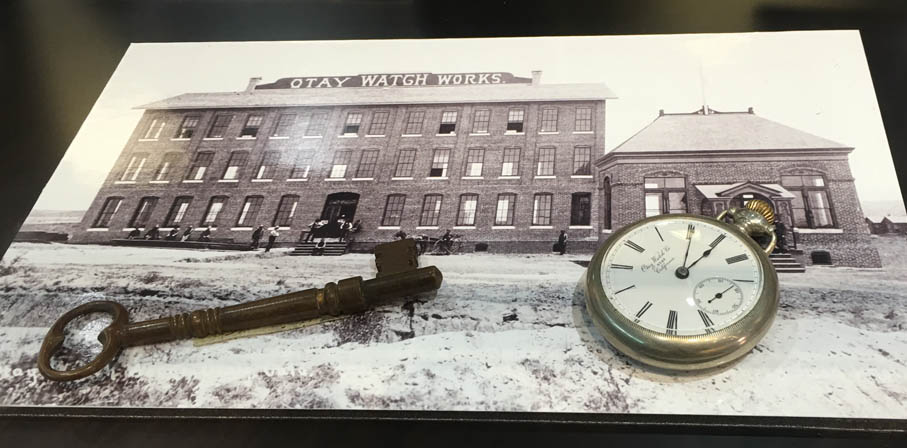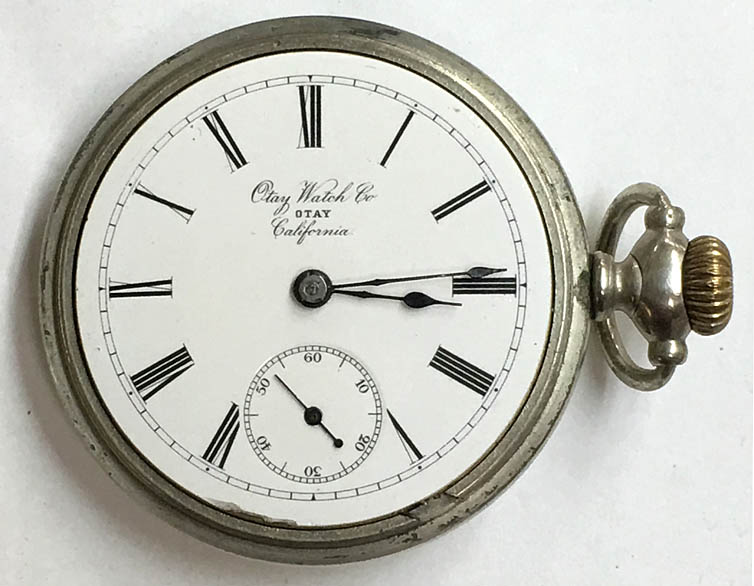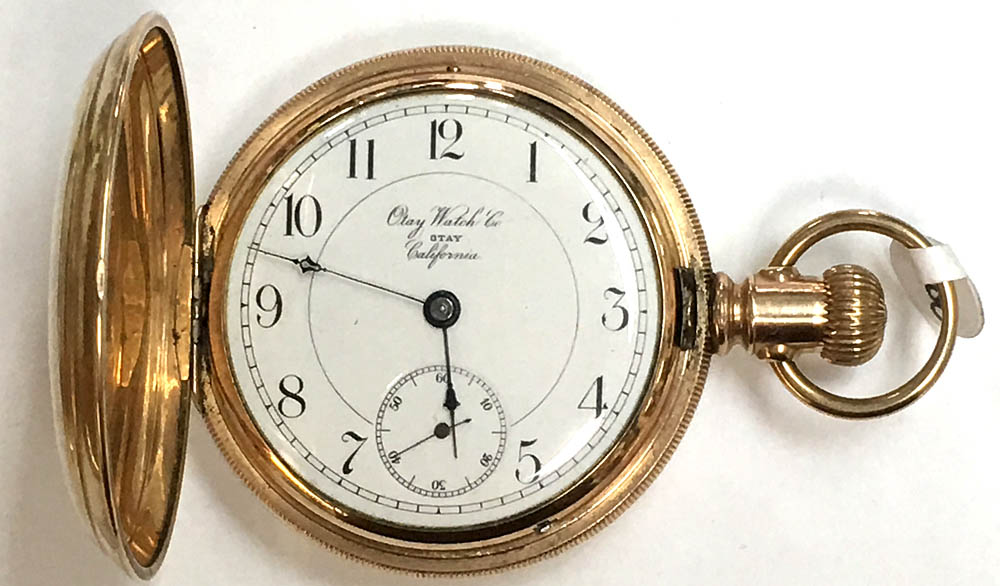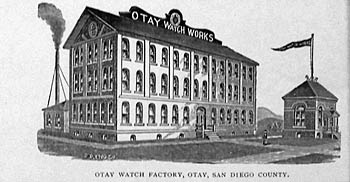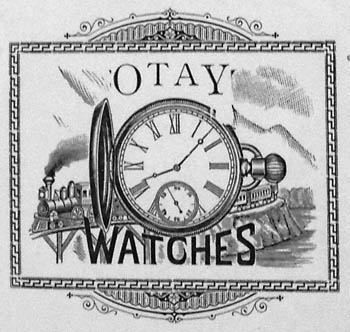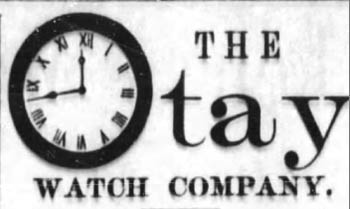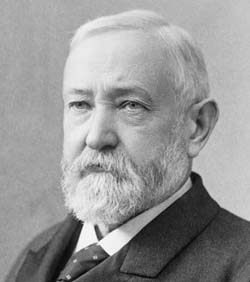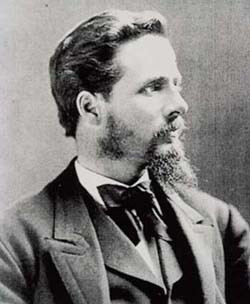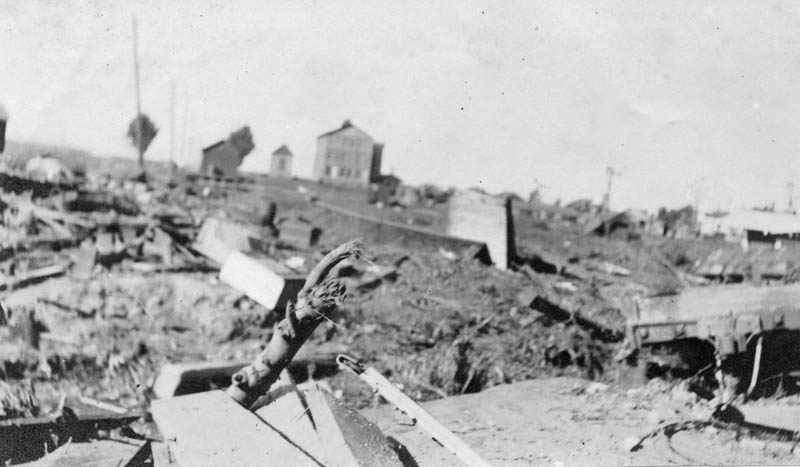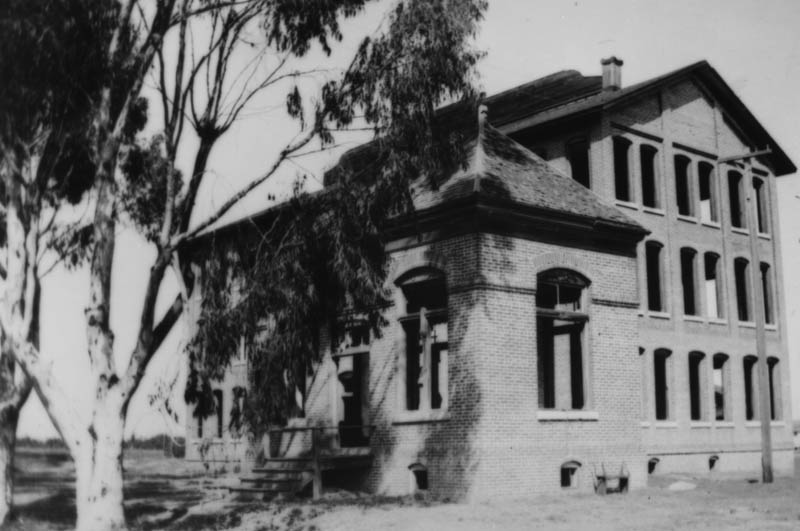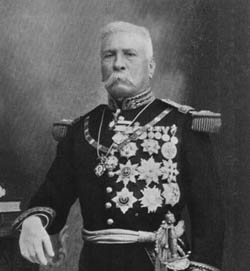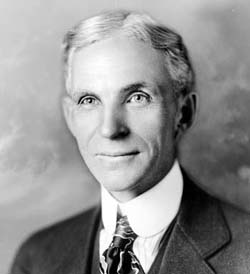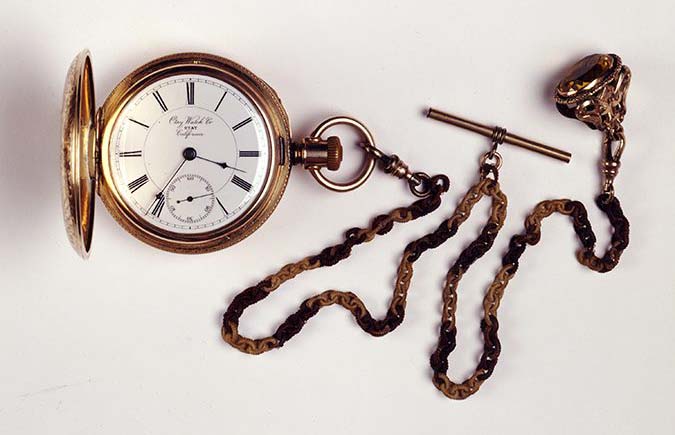|
Otay Watch Factory
This photo was on display in the Chula Vista Heritage Museum Great Flood exhibit during 2016. The factory key and watch were donated by Lawrence and Ray Downs. The article "It's About Time" (download PDF) tells the story of this watch. It was submitted by Bill Aitken of Colorado Springs CO in 1988. This is about the most complete story of the Otay watch. Mr. Aitken donated the Otay watch to the Chula Vista Historical Society. This watch was given to Aitken by Sam Dale in about 1920. Our Otay watch has the serial number 1340. Jon Hanson of Beverly Hills, antiquarian Horologist, specializing in early American pocket watches, states that our watch may have been one of the earliest made since it did not have a model name. According to Aitken, "If the Otay serial numbers between the lowest and highest were all made, the production would have been something over 29,000 a most creditable performance in the period between the signing of the contract with Wheeler, February 25, 1889, and the sheriff's closure, October 13, 1890. Personally I have seen or known of about twenty examples numbered only between 1208 and 1340 and between 30110 and 30637." (Chula Vista Historical Society Bulletin, January, 1988, pp. 8-13) An early Otay watch with serial number 1340 (Chula Vista Heritage Museum) A later Otay watch with hunter case (Dave Rossi of Chula Vista) Along the Otay, The Otay Watch Company. "In the early twenties, Mr. Charles A. Manahan, who was the secretary of the American National Jewelers Association wrote, "I wish I could have known the man who promoted the Otay Watch Company factory, he must have been a wonder - at any rate, the promoter, whoever he was, stands at the head of all California realtors who followed." Whoever the prime mover was, in the project of making a watch factory the nucleus of a booming city at Otay, is not very clear. Using a watch manufacturing plant for such a purpose was not a new idea, nor a very successful venture, as had been demonstrated by failures at Marion, Ann Arbor, Rock Island, Freeport, Peoria, Wichita, Grand Crossing, San Francisco, Appleton, Fredonia, Atlanta, and Aurora. In 1830 there were only two watch companies in the United States, but by 1880 there were twelve companies and they were located on the Atlantic Coast to the midwest - none on the Pacific Coast. Seven of the twelve companies made excellent watches, nine of the twelve also made a cheaper model, seven jewels, sometimes known as a workingman's watch. This watch would retail for five dollars to twelve dollars. Eight of the watch factories produced a high grade time piece. The Otay Watch Company was one of the companies that did produce a cheaper or competitive grade watch along with the best. There were seven qualities a high grade watch must have: quality, workmanship, engineering, design, appearance, and most important, time keeping ability. The Otay watch was equal in comparison in all seven qualities. The Otay watch came in several models and had model names, such as; Otay Watch Company, P. H. Wheeler, Golden Gate, Overland Mail, Native Son, F. A. Kimball, California, and the R. D. Perry. They all had the same design, and had eleven to fifteen jewels. Some were gilded and some were damaskeened. Several had top plate jewels in gold settings, all had the winding at the figure three. The figures were in Roman or Arabic. Years later, about 1912, Frank Kimball took his watch in for repairs to Sam Dale's Jewelry Store on "F" Street in San Diego, Frank would say to Sam, "Be careful of this watch, it's my $30,000 Otay Watch". This is the amount Frank Kimball lost on his investment with the Otay Watch Company. In fact, the watches were very expensive for the period. The wholesale prices started at $40.00 for the cheaper model, $50.00 for the next and on up to $90.00. The retail prices would be double the wholesale price." (Chula Vista Historical Society Bulletin October, 1982, p. 6) 1889 - The Otay Watch Factory was built in 1889. It was the largest and most elaborate building in the area. The company was brought here to put people to work and to help develop the town of Otay. There were very few houses In this area at that time. The main building was a three-story brick factory with 12 foot ceilings. The walls were 24 inches thick on the ground floor and 18 inches thick on the third floor. It took 275,000 bricks to complete the building. It measured 30 feet by 100 feet and had 125 windows. This building stood on the southeast corner of Tremont and Fresno Streets. Not one brick remains today, The Otay Watch Company was in business for only 174 days. The watches were satisfactory, but they were expensive and sold slowly. A lack of operating capital caused the factory to close in October, 1890. The building was used for various purposes until it was torn down in 1934. Anita Brown Amos remembers taking ballet lessons there with Flora Downs. Mr. Rolin D. Downs remembers rollerskating on the second floor. Mrs. La Ventia Premo Hickley and Mrs. Clella B. Kuebler remember attending dances there. Mrs. Kuebler: "Dancing was on the second floor and refreshments were served on the third floor. They had an orchestra. People used to come from all over. We'd dance the waltz and the two step." ( OTAY WATCH FACTORY by Freddy C. Perez in"The Young Historians Student Booklet Otay and Otay Mesa," Montgomery School, n. d. [1983] ) 1889/02/05 - For many years, people driving through the Otay Valley came upon a large three-story brick building, looming high above the surrounding rural landscape, like a sphinx in the desert - the Otay Watch Company kept its counsel while speculation and opinion ran rampant. This building stood on the southeast corner of Tremont and Fresno Streets, but not one brick remains, and every vestige of this incredible adventure in industry has disappeared. In 1886, the San Diego Land and Town Company, which had taken most of Kimball's National Ranch to bring the railroad to San Diego County, organized the National City and Otay Railroad Company to connect the South Bay Communities with San Diego and National City. Mr. Guion, Mr. Hartley, and Mr. Hamilton, whose real estate office was on the southeast corner of Sixth and "E" Streets in San Diego were the promoters for the sale of land in the proposed new town of Otay, the homestead lands which had belonged to R. D. Perry. The town progressed and was officially opened on October 26, 1887, and on March 14, 1889, an announcement came that a Watch Factory was to be constructed in town. The firm of Guion, Hartley, and Hamilton were credited with investigating this enterprise. The Otay Watch Company was organized on February 5, 1889. The building was started and the basement excavated. George Engel was the engineer and A. T. Large was the builder and contractor. Mr. Large had his architect office in San Diego, and did work on the Hotel del Coronado. The building was 30'x100' and had 125 windows. The brick was from the Sweetwater Brick Kilns of the Kimball Brothers. It took 275,000 bricks to complete the building. The office, boiler, and engine rooms were separate from the main building. The office was 10'x16', the boiler room was 25'x40', and the engine room 15'x20'. Both structures were built like the main building. The thickness of the foundation was 4' and 2' at the lower floor ,graduating to 18" on the third floor. The three floors of the main building are double and made of Georgia pine. The side walls are of solid cement and the window sills as well as the main entrances both rear and front, are of white stone. The sign on top of the building was 80'x4'. The Cottier system of ventilation ws used throughout the building. The exit of the water closets passed through flues twenty inches in diameter, with inverted funnels situated in the main flues above the roof of the main building, similar to those seen on ocean steamers. The Otay Watch Company functioned for approximately 174 days. The building was used for various purposes until 1934. when it was razed. Nelson Snyder of the San Diego Towel Supply Company was the last owner. A Chicago firm submitted the low bid to raze the building. It was their intention to dynamite it, then clean the brick. The County Board of Supervisors refused to grant a permit, so the building had to be taken down brick by brick. This was the end of the building, where, for a few short months, TIME was made. Some of the senior members of our Historical Society can remember attending the Saturday night dances of the early 1920s. Dancing was on the second floor and refreshments and goodies served on the third floor. Anita Brown Amos can remember taking her ballet lessons here with Flora Downs, who later became San Diego's first truly outstanding ballerina, and who was a founding member of the San Diego Ballet Company. ( Chula Vista Historical Society Bulletin, Sept. 1982 ) 1889/03/28 The first floor of Otay Watch Factory was almost complete. ( Otay Press, March 28, 1889 ) 1889/03/28 - The Otay Watch Factory is now assuming stately proportions. The first story of the Factory is in progress, and the fine office building, 18x30, is about enclosed, and will soon be ready for occupance. The carpenters are in advance with their work and the general construction of the factory, under such headway, with architect Large, cannot be be long in reaching completion, and making ready for the introduction of the machinery, that will probably, be run by water power, conducted from the Sweetwater Dam, In the near future the buzz of machinery will be heard in the land, and many busy hands will be needed to manipulate the work, houses must be built, improvements wili be made, aud Otay will hum with a busy populace that will make the surrounding country glad. ( Otay Press, Mar 28, 1889) 1889/04/04 - The Otay Watch Factory is fast nearing completion and will employ 400 operatives; additional stores are being built; school houses on a larger and more commodious scale are being built. There is not a vacant house or room in the whole town or valley; but in four or five weeks, buildings will be furnished to accommodate the steady flow of strangers. Lots are being sold reasonably and on easy terms. $100, $200, $300 for town lots and good acre land can be had $100, $200 and $300 per acre and plenty of water. The town will be lighted by electricity by the middle of April. ( Otay Press, Apr 4, 1889) 1889/04/18 - The following are the Officers for the Otay Watch Company, headquarters at Otay : President, R. D. Perry; Gen. Manager, J. H. Guion; Gen. Superintendent, P. H. Wheeler; Sec'y, J. W. McCool ( Otay Press, Apr 18, 1889) 1889/04/18 - Work on the massive three story brick structure, the Otay Watch Factory, is going steadily forward. This week, the wood work for the second story is in place, and the brick-layers are carrying up the walls at a rapid rate. The engine house is about completed and the office building is undergoing the finishing touch. The elevator, for hoisting material in the center of the building, that is run by horse power, is working like a charm and the whole business is moving forward in good shape. ( Otay Press, Apr 18, 1889) 1889/04/25 - Otay Watch Co officers: President, R. D. Perry; General Manager J. H. Guion; General Superintendent P. H. Wheeler; Secretary J. W. McCool. This week, the officers of the Otay Watch Company moved into their new office, which is a fine, well finished brick building 18x30 with double and transom windows, high ceiling and hard finish, and from a staff on its summit floats the ensign of the Otay Watch Factory. ( Otay Press, Apr. 25, 1889 ) 1889/04/25 - This week, the officers of the Otay Watch Company moved into their new office, which is a fine, well finished brick building 18x30 with double and transom windows, high ceiling and hard finish, and from a staff on its summit floats the ensign of the Otay Watch Factory. ( Otay Press, Apr. 25, 1889 ) 1889/05/02 - Otay Watch Factory under construction, 30x100 ft with 125 windows ( Otay Press, May 2, 1889 ) 1889/05/09 - The massive structure overlooking all other industry in the valley, the watch Factory has now reached its third and last story in height, and the gables are now being built, prepatory to putting on the roof, and the bricklaying is about done. The window and door frames are being painted, and the work of flooring, ceiling and plastering will soon be commenced. The pulleys and hangers for the machinery have been received. The Company have now purchased two Westinghouse engines 35 HP, two 40-horse power boilers, two 150 incandescent electric light dynamos, and it is said to be the most substantial plant in the state, costing $12,000. The machinery is arriving and the engines will soon be in place. One can form some idea of the colossal magnitude of the plant, by its requiring seven cars for its transportation. The office of the Factory, now occupied, is finely designed and finished with Cottier's system of ventilation, making it one of the most pleasant and tasty offices found in many a days travel. ( Otay Press, May 9, 1889. ) 1889 - The Otay Watch Company built a three-story brick building and installed an electric light plant from the Pierce-Morse Block in San Diego. ( Menzel, 1942. ) 1889/05/16 - The New School House. Otay's fine two-story School House, that has been keeping pace with the Watch Factory in building, has now been roofed and completely enclosed and ready for the doors and windows. The belfry, that comes up to the height of twenty feet from the roof, is being completed by the carpenters this week. The building has received one coat of paint as a priming for a coat of white which will soon be applied. Mr. Griffith, the plasterer, is putting on a good, hard finish for the walls of the lower story, and the finishing of the second story is expected to be carried forward when the first story shall have been completed. ( Otay Press, May 16, 1889 ) 1889/05/16 - In chronicling the steady progress of the building of the Watch Factory from week to week, as it reared its symmetrical proportions, overlooking the valley, we have mentioned many of its component parts, and this week of its upbuilding, we are pleased to note that the brick work on the Factory has been completed, and the carpenters are at work putting on the cornice and roof. On the ridge of the roof, sixty feet from the ground, will be placed a large sign five feet in width, on which will be inscribed, "Otay Watch Works," which can be plainly read for miles up and down the valley. Shaftings with two Westinghouse Engines, 35-horsepower each, two 40-horsepower boilers, two 250 incandescent electric light dynamos, costing $12,000, are now on the ground, and the work of putting them in place is going forward. When the running power is in place and the necessary machinery ordered from Waltham, Mass., has arrived, the business of making 25 or 30 machines used for fine work, will be commenced, the designs of which have already been completed by Supt. P. H. Wheeler. The dynamos for the Edison electric light plant will be used to generate electricity for lighting the factory and town. The three floors will be classified for different work, The first floor being devoted to the making of plates, gilding and dials. The second floor will be used for the work of escapements, jewels and screws. The third floor will be used for the work of escapements, jewels and screws. The third floor, where the watch will be completed, operatives will train, stem-wind, demascene and finish, and when the factory is satisfactorily running, about 250 watches per day will be turned out. ( Otay Press, May 16, 1889 ) 1889/06/06 - The massive, three-story structure of the Otay Watch Works is now about completed. The 35-horse-power engines, Westinghouse pattern, and two 40-horse-power boilers and two 250-light dynamos are on the ground and are being placed in operation. The boilers are made of steel and took first-prize at the San Francisco Exposition. The dynamos are of the Ediaon system and the entire plant of engine, boilers and dynamos coat $12,000 and are considered the finest plant of motive and electric power in California. The first floor will be ready to occupy this week and several tool makers are on the ground ready for business and are now assisting in placing the machinery in position. Machinery has been ordered by telegraph from the American Watch Tool Co., of Waltham, Mass., for the machine shop. Mr. Montrose of Elgin, Mr. Chase of Boston, Mr. Detriek of Chicago, Mr. Harbler of Springfield Ill. and the Knopf Bros, of Columbus O. are assisting in placing the machinery in position. The office beyond doubt is the finest appearing and the finest finished building of kind in California. The main building of the factory cannot be equalled in the United States for manufacturing purposes, it costing $25,000, and the office alone costing $2,000. The lawn in front of the factory is being graded and will he set out in palm and orange trees, The walks will have all the rare flowers of this tropical clime on either side, and when the last detail of the plans are completed, the Company can defy the world as to buildings, motive power, climate, sightly surroundings and ventilation. (this is a repeat of an article published May 30) ( Otay Press, Jun 6, 1889 ) 1889/06/13 - The only Watch Factory west of the Mississippi is now completed, and the engine, boilers and heavy machinery are in place. The new smokestack, manufactured by Isham, Gordon & Co., is now on the ground ready to be put up. The stack will be of steel, sixty feet in height, secured by cables. On the ridge of the roof, painters are at work on the massive sign, eighty feet long and five in width, on which will be inscribed "Otay Watch Works," the grounds in front of office and factory are being graded and will be beautified with lawn, trees, shrubs and flowers. The work of fitting up for the making of the smaller machinery, tools and dies is being pushed forward, and when the necessary machinery ordered from Waltham, Mass., has arrived, experts will proceed with the delicate and complicated work of equipping the factory for active operation, all of which will require time and skill. A grand ball and supper will be given at Otay tonight, Thursday evening, June 13th. The dance and supper will take place in the second and third stories of the new Watch Factory. Ample arrangements have been made, good music will be furnished, and the spacious halls will afford room for all. The dance will be under the auspices of the Otay Literary Society for the benefit of a Town Hall. ( Otay Press, June 13, 1889. ) 1889/06/20 - At last Thursday [June 13] Grand Ball, spacious halls 38x100 were illuminated for the first time, 50 couples were present, music by the Otay Orchestra (that plays for the Literary Society) consisting of violin, cornet, clarinet and harp, and to the prompting call of Will Burke, amid the ducet strains, the dance went round till an early hour. Forty dollars were the net receipts for the evening. An extra train was run from Tia Juana, bringing many from the south side - list of names of attendees. The first floor of the Watch Factory is all completed, with the benches in, ready for the business of making the machinery for manufacture of watches. The light machinery for the operation has been shipped as fast freight from the East, and is expected here in a few days. Pipes for the water supply are being laid from the Sweetwater main, and the engine will soon be started up. The Knopf Bros. are doing a fine job in lettering the mammoth sign, 5x80 feet, which can be read for miles up or down the valley. The increase of business at the office of the company, has necessitated the introduction of a typewriter. ( Otay Press, June 20, 1889 ) 1889/06/27 - The building is now complete, Engine and Boiler are placed in a substantial manner. The shafting and hangers are being placed in position. P. H. Wheeler the Superintendent has returned from San Francisco where he met the Eastern agents, and has made arrangements for all of the machinery and all of which is on the road here. The town is now being piped with the Sweetwater system, the Wathch Co having purchased the pipe and are laying the line themselves, thereby owning the system within the town site limits. J. H. Guion is Watch Factory manager. This week, Mr. Joseph Dietrich, engineer in the Watch Factory, is building a house on Third Avenue and when completed will move his family here. ( Otay Press, June 27, 1889 )
1889/08/01 - The services of Miss Nina Hettick has been secured as type-writer for the Otay Watch Company ( Otay Press, Aug. 1, 1889. ) 1889/08/29 - A palm tree 15 feet high growing in the Otay watch factory lawn. The new machinery was received last week and all the lathes ar the watch factory are running like clockwork, and the business of tool making is now being pushed forward for the more immediate work on the construction of watches, a model of which is now about completed. The initial steps in watch building necessarily requires much time, skill and experience, demanding the service of master mechanics and experts in every department. Among the number of those secured and now at work in the factory are: Messrs Geo. F. Kreiger of elgin Ill; George E. Flick of Clumbus Ohio; B. Montrose of Elgin Ill; henry Barier of Springfield Ill; Henry Chase of Boston Mass; N. A. Wheeler of Minneapolis Minn.; N. L. Hayden, Jas. Dietrick and Knoff Brothers, and others are continuing to arrive, and new faces are becoming familiar on our streets very day, and in the near future local help will be introduced to the timely art, under the instruction of mor advanced operators, and under the supervision of P. H. Wheeler of long and successful experience, the business is moving forward with neatness and precision. ( Otay Press, Aug. 29, 1889 )
1889/09/12 - 200 attended the dance last Friday at the Otay Watch Factory, added $75 to fund now at $200. During the evening an opportunity was given for visitors to inspect the new machinery now employed in the manufacture of watches and to see the first model Otay watch in motion and listen to the ticks of time that are to make our futur great. ( Otay Press, Sept. 12, 1889 ) 1889/09/19 - 25 men working at the Otay Watch Factory making tools and machinery. The model watch that has ben set up to test the running gear was a source of great attraction for several days but the movement proving satisfactory, the watch has been taken down and the work of duplicating the same has begun. Carload of coal arrived this week for the factory. ( Otay Press, Sept. 19, 1889 ) 1889/09/26 - Baseball game at Recreation Park for championship of the San Diego League Sunday drew large crowd. Schiller & Murthas defeated F. N. Hamilton 8-5. Lou Sylvester from the Otay Watch Factory played for the S & Ms who will play next week at the Fair in Escondido. ( Otay Press, Sept. 26, 1889 ) 1889/10/10 - Articles of incorporation have been filed for the establishment of the "Otay Pottery," with a capital stock of $60,000. Work will soon be commenced under the management of the able expert Prof. Weatherby. The site for the building is west of the Watch Factory, adjacent to the railroad, and handy for shipments. Will manufacture fruit jars and other vessels. On Wed. last, brick was delivered on the gound for the new Otay Porcelain and Pottery Works, located on Main /ave, west of the RR depot. The main building will be two stories in heiht, 16x50 feet with an open court on the west with 100 feet of shedding. President and Director, Ranford Worthing; Secretary and Director, P. H. Wheeer; Directors, Clara Foltz, J. H. Guion, Henry Fairweather ( Otay Press, Oct. 10, 17, 24, 1889 ) 1889/11/14 - Otay Watch Company has terraced lawn with cement walks. ( Otay Press, Nov. 14, 1889 ) 1889/12/26 - Theater drama of 5 acts at the Otay Watch Works last Friday, everybody in the valley turned out and a number from the Mesa and San Diego were present, another performance tomorrow. Over 50 houses may now be seen in Otay, where but two years ago it numbered only five. ( Otay Press, Dec. 26, 1889 )
1890 - Along the Otay, The Otay Watch Company. In the early twenties, Mr. Charles A. Manahan, who was the secretary of the American National Jewelers Association wrote, "I wish I could have known the man who promoted the Otay Watch Company factory, he must have been a wonder - at any rate, the promoter, whoever he was, stands at the head of all California realtors who followed." Whoever the prime mover was, in the project of making a watch factory the nucleus of a booming city at Otay, is not very clear. Using a watch manufacturing plant for such a purpose was not a new idea, nor a very successful venture, as had been demonstrated by failures at Marion, Ann Arbor, Rock Island, Freeport, Peoria, Wichita, Grand Crossing, San Francisco, Appleton, Fredonia, Atlanta, and Aurora. In 1830 there were only two watch companies in the United States, but by 1880 there were twelve companies and they were located on the Atlantic Coast to the midwest - none on the Pacific Coast. Seven of the twelve companies made excellent watches, nine of the twelve also made a cheaper model, seven jewels, sometimes known as a workingman's watch. This watch would retail for five dollars to twelve dollars. Eight of the watch factories produced a high grade time piece. The Otay Watch Company was one of the companies that did produce a cheaper or competitive grade watch along with the best. There were seven qualities a high grade watch must have: quality, workmanship, engineering, design, appearance, and most important, time keeping ability. The Otay watch was equal in comparison in all seven qualities. The Otay watch came in several models and had model names, such as; Otay Watch Company, P. H. Wheeler, Golden Gate, Overland Mail, Native Son, F. A. Kimball, California, and the R. D. Perry. They all had the same design, and had eleven to fifteen jewels. Some were gilded and some were damaskeened. Several had top plate jewels in gold settings, all had the winding at the figure three. The figures were in Roman or Arabic. Years later, about 1912, Frank Kimball took his watch in for repairs to Sam Dale's Jewelry Store on "F" Street in San Diego, Frank would say to Sam, "Be careful of this watch, it's my $30,000 Otay Watch". This is the amount Frank Kimball lost on his investment with the Otay Watch Company. In fact, the watches were very expensive for the period. The wholesale prices started at $40.00 for the cheaper model, $50.00 for the next and on up to $90.00. The retail prices would be double the wholesale price. ( Chula Vista Historical Society Bulletin October, 1982, p. 6 ) Otay watch from the collections of the Bonita Museum
1890/01/16 - A large consignment of machinery has been recieved and placed in position, It can be said without fear of contradiction, that the Otay Watch Co. now has the finest machinery ever seen this side of the Mississippi River. Gen. Manager J. H. Guion of the Otay Watch Company, tendered his resignation for reasons of his own, and by special meeting of Directors, his resignation was discussed and finely accepted according to request. A vote of thanks was tendered Mr. Guion for his untireing efforts in raising so fine an institution as the Otay Watch Company in our midst, and all express regret, one and all. Mr. Frank A. Kinball, President of the Bank of National City, was duly elected General Manager of the Otay Watch Company, to date from January 15th, 1890. ( Otay Press, Jan 16, 1890 ) 1890/02/6 - Otay Watch Factory commenced the manufacture of watches on Thursday, Feb. 6 ( Otay Press, Feb 13, 1890 ) 1890/02/06 - Front page story on Otay Watch Factory by J. M. Roraback Miss Nina Hettick has resigned as stenographer at the Watch Factory and returned to National City. ( Otay Press, Feb. 6, 1890 ) 1890/02/06 - The excursion trains on the NC&O railway are now well-patronized and from three to four coach-loads of passengers are carried over the rout two or three times a week. ( Otay Press, Feb 6, 1890 ) 1890/03/06 - Frank Kimball dispersed wages of $3000 on the first of the month to watch makers; machinery for the Otay Watch Company still arriving, and "the making of watches is progressing rapidly." (list of names of the watch makers). ( Otay Press, Mar. 6, 1890 ) 1890/03/13 - The Otay Watch factory averages a visit of about 25 persons daily, many from all parts of the world. The first watches being turned out are 15-jewel, gilt stem wind and set, patent regulator; adjusted, double sunk dials, Arabic figures, and will be named F. A. Kimball, Otay, Calif. The last quota of experts will arrive from the East tomorrow and will be escorted to the hotel by the Otay Watch Co.'s brass band. ( Otay Press, Mar. 13, 1890 ) 1890/10/13 - Factory was completed in 1889 but was foreclosed by sheriff on October 13, 1890. Many of the citizens of National City invested money in this enterprise at a loss to them. Building was located south of Fresno and Tremont Streets in Otay. ( Bonita Museum ) 1890/11/20 - MARRIED AT SEA. Parents Left on the Wharf. The Bride Is Only Fifteen Years Old. Sensational Elopement of Allot K. Johnson and Lola Hay Perry of San Diego. The Pacific Coast Steamship Company's steamer Santa Rosa, which arrived Monday from San Diego, was the scene of a most romantic, if not thrilling, experience on her up trip. Among her passengers were Misses Lillian Buer ans Moilie Shade, two young ladies from San Diego, who within a week have been bridesmaids on the high seas. The names of the couple joined in wedlock are Alma K. Johnson and Miss Lola May Perry, both of Otay, Snn Diego. The circumstances of the marriage were told yesterday to a Chronicle reporter. Otay has earned the dignity of a township only within the past few years. Prior to that time its site was a waste with an oasis in the shape of a summer hotel and a lone dwelling. With the organization of the Otay Watch Company boom set in. A factory for the manufacture of watches was built and several hundred hands are now employed there. The manager of the concern is Mr. Perry, who is said to have considerable wealth. His daughter, Lola May, is a handsome womanly miss of 13 tropic summers. Perry had in his employ as clerk a young man named Alma K. Johnson, who at one time resided in this city. The two young people were thrown frequently together and manifested the utmost affection for each other. Their youth precluded any suspicion as to immediate marriage and Cupid had an open held and no opposition. Johnson finally proposed to marry the fair Lola, and she consented. Her tender age would not allow the ceremony to be pertormed in the usual maimer, and it was decided to charter a tug and a minister and have the knot tied on the high seas. As a tug could not be procured, a time-worn precedent had to be abandoned and a yacht called the Sappho was hired. One day last week Johnson and Lola, accompanied by Rev. F. D. Seward, a Presbyterian minister: Misses Buer and Shade, and several oilier friends went aboard the Sappho and sailed outside the San Diego Heads. Scarcely had the little yacht attained a distance of several hundred yards from the wharf than the bride's parents came rushing down to the dock to interrupt the runaways. They were a trifle too late. Once outside the heads Rev. Mr. Stewart tied the knot, and Mr. and Mrs. Johnson received the congratulations of their friends on board. The bridegroom in expectancy of the event had calculated on making a hasty exit from San Diego with his wife, and to that end had purchased two through tickets for passage on a steamer to Santa Rosa for San Francisco. Just as the ceremony was performed, however, the Santa Rosa was observed backing out of her dock seaward. The anxious bridegroom had to face the alternatives ot being detained by an angry father-in-law if he landed at the wharf, or else of staying on board the Sappho and missing the steamer. Captain Crane ot the Sappho solved the difficulty by lowering a small boat and placing himself, the bridesmaids and the newly married couple in it. The little craft shot out in the direction of the receding steamer, and managed to get alongside. Mr. and Mrs. Johnson, accompanied by the bridesmaids, jumped aboard and the Santa Rosa proceeded on her way. Mr. Johnson thought that the telegraph might work him injury. To avoid it he left the steamer at San Pedro, went to Los Angeles by rail, and by this time is well on his way to the City of Mexico, where he and his bride will make their home until pardoned by the irate parents of Mrs. Johnson. ( San Francisco Chronicle, Nov 20, 1890 )
1893/08/18 - Kimball wrote letter Aug. 18, 1893, that he sold the Otay watch factory for $20,000. ( Phillips, "Diaries of Frank A. Kimball" ) 1900 - Otay resident Will W. Fletcher 1887-1906, has an Overland Mail watch from Otay Watch Factory. Fletcher's father was H. H. Fletcher and his uncle was A. T. Large, well-known early San Diego architect, helped with Hotel del Coronado, was a builder of the Otay Watch Factory. ( Chula Vista Star, Mar. 19, 1937. ) 1900 - I remember when they used to have an Otay Watch Factory in Otay. I didn't work there, but I saw it when it was built. Quite a few people came in there to work in the factory. My brother and I used to go around and sell stuff to the people there, sell vegetables to the people that were working in the factory. It ran for several years. They made a lot of good watches. I don't know anyone who has one. I suppose they went busted; I don't know. We used to hear the whistle. They'd blow the whistle in the morning, at noon, and night. You could hear the whistle from our ranch up there. ( Poggi, 1959)
1910 - Inauguration of the new extension started on New Year's Day, 1910, with a total of nIne trains being routed through to Otay. The terminal at Otay had a siding long enough for a short steam train or electric motor-trailer set to change cars and run around the trailer. The small Otay watch factory near the terminal turned out to be a good source of revenue for the line. ( Forty, 1987. ) 1911 - My father, Claude V. Brown, came to San Diego from Burbank to work on the U S Grant Hotel in 1909. In 1911, he came to Chula Vista and started farming, pioneering in the raising of celery My father, who was known as "Brownie," gave dances at the old Otay Watch Factory. ( Family, Friends, and Homes, 1991, pp. 29-30. ) 1915 - THE SAGA OF WATCH No. 1219. Otay Watch No. 1219 has been in the Murphy Family for over forty years. John's brother, James J. Murphy, who lived in Douglas, Arizona, went to the Mexican line at Agua Prieta. There was a skirmish in that area and Mexican soldiers were patrolling the line, A Mexican soldier motioned to James Murphy to come up to the fence, the soldier showed this watch and asked for money for it. James or Jim (nickname) recognized the watch as being gold and very old so he gave the soldier $5.00 for it, and the soldier was very happy to get the money. When Jim opened the watch, he saw the name, "Otay Watch Company". Some time later, John and Mary Murphy visited their brother, Jim, and Jim gave the watch to John and Mary because they knew the history of the Otay Watch Company. Mary Murphy had been Mary Campbell before she married John and had lived a few blocks from the Otay Watch Factory. They all had gone to the dances of the San Souci Club on Saturday nights but did not know each other at that time (1919-1924). The Murphy's stored their treasure with their old family heirlooms for several years before they gave it to Elmer and Kitty Muhls to display in their jewelry store on Orange Avenue in Coronado. Elmer cleaned the old watch and got it to working, put it on a Keepsake Watch Stand, and displayed it in their window; From that display they sold many Keepsake Stands. When they retired in 1972, they returned it to the Murphy's with the Stand. In 1978, the Murphy's gave the old watch to a friend of theirs that collected antique watches. John and Mary Murphy wish they knew how and when the Mexican Soldier acquired the watch, although their brother, Jim, knew some Spanish, the Soldier knew no English. James J. Murphy died in 1970. Mary (Maisie) Campbell Murphy John (Johnny; P. Murphy (Spring Valley, California) ( Chula Vista Historical Society Bulletin October, 1982, p. 7 )
The Otay Watch Factory was one of the few buildings left standing after the flood of 1916.
1920 - A LOVE STORY AT THE OTAY WATCH FACTORY by Meneva Latham. As a prelude to this story, I will tell you a little about my life before I came to California. My father ran cattle on the range in Southern Utah. Every fall we went to the fair in Salt Lake, there we would go to all the shows. I was a teenager and thought the shows were wonderful. I remember one vaudeville team of dancers that were excellent. We moved to Otay in Sept. 1919. We leased the Williams place, it was at Anita and Broadway. We had an option to buy it for $10,000. Ten acres, a well, a reservoir, a big barn and a big house. Due to a combination of events my father went broke in the cattle business and we did not buy it. Our next door neighbor was Charles Shaver, principal of the Chula Vista elementary school. there was a monthly social and business event in Otay at that time. The Otay Welfare League, it was not welfare in the way we use the term now. It was more like a Farm Bureau or Chamber of Commerce. There was a business meeting and then a program and refreshments after the business. Mr. Shaver was president of this League. The Hyers had a ranch at Anita and Industrial, they had a daughter Viola, we became good friends. One day Viola picked me up in her car and we went for a ride. We stopped at the old Watch Factory and went in. It was dirty and in bad repair, we decided it would be a grand place to have a halloween party, so we took the idea to the Otay Welfare League at their next meeting. This must have been about August, 1920. A group of older people got to work on the idea and we had the Halloween party. Evidently the workers in the factory had stood on their feet to do their work. There were old benches nailed to the walls all around the big rooms. These benches were heavy timbers, rough and full of slivers. The men lowered the benches down to the correct height to sit on. Every one worked and scrubbed to clean the place up. That started the ball rolling. A club was formed, called the San Souci Club, Walter Sharp was president. There was a young couple in Otay, managing a turkey ranch, Dave and Arlene Richardson. We became acquainted with them. They were a retired vaudeville team, the same ones we had seen in Salt Lake. They started giving us dancing lessons. Dave and Arlene separated and Arlene gave dancing lessons to make a living. Arlene also had a dancing class in Chula Vista, one of her students in that class was a young man by the name of Bill Latham. One night he came down to the Otay Watch Factory to a dance. Mrs. Bill Riley introduced him to me. We were married Sept. 11, 1924. Bill Riley was for many years a foreman in the Chula Vista Citrus Ass'n Packing House at Third and K. So you see the Otay Watch Factory and that vaudeville team played a big part in my life. In the Watch Factory, we did not use the lower floor very much, we danced on the second floor and used the top floor for refreshments. Some people I remember at our dances. Bob McCan and Theresa, Cox McCan, Tom McCan, Johnny LaPorte and Marie Patterson LaPorte, Ethel Patterson, Marlyn Bryant Huntermer, Earl and Arlene Black, Ray Downs, Danny Wright, Mr. & Mrs. Walter Sharp and his sister Adeline Sharpe (later Mrs. Roy Lawton) Roy Lawton, Johnny Grieffe, Mr. & Mrs. Bill Riley, Mr. & Mrs. Johnson, Claude and Ethel Brown. He was called Chula Vista Brown, was mayor at one time and introduced the growing of celery in Chula Vista. Ethel had a beauty parlor in her home. She could give a beautiful Marcel. If you have had a Marcel, you are over the hill. ( Chula Vista Historical Society Bulletin, Oct. 1984) Otay Watch Company building ca. 1930. Only the trees in front remained at location. (Courtesy Dorothy Banks Frazier, Bonita Museum)
1934/06/01 - Watch Purchase Recalls Old Time Memories by James Arthur. Poignant memories of days gone by were recalled to Dale Smith, city clerk of National City, last week when he was sought out by a representative of Henry Ford, who was anxious to purchase a watch manufactured in the old Otay watch factory whose decrepit sagging building is a familiar landmark to residents of the South Bay. Smith, who worked In the factory, cutting teeth on the steel wheels of the watch works, purchased two of the watches at the sheriff's sale when the business failed. His twin sisters Hattie and Mattie Smith, crowned and set jewels in the watch factory. At that time Otay was a thrivIng community of about 1,500 persons, says Smith. There was considerable building activity and the town was the center of an active farming community. Water was purchased from the Sweetwater reservoir as at present. The watch factory had over 130 employes. Practically all the buildings have since been moved away. The watch purchased from Smith by Jack Woolley, Long Beach, general representative of the Ford Motor company is one of only six of its kind ever made, a make once designated by the late President Diaz as "the official, recognised railroad watch in Mexico."
1934/08/24 - Otay Optimistic in Boom Days. For us, chief interest now centers about the old ruinated watch factory, about all that remains of this dream of the promoters. In the Golden Era of September, 1889, we find this pertinent article: "The Otay Watch Company in Otay, San Diego county, California has a capacity of 250 watches a day, and power to work 600 men. The work is being pushed forward with all possible speed. Their model watches are completed and are running to the company's satisfaction, and on their being placed on the market will no doubt speak for themselves and do credit to southern California. The company has laid 2 and 1/2 miles of water pipe at its own expense for supplying the factory and the town, the watet being furnished by the Sweetwater system. The town is growing very fast and is being populated by watchmakers and people employed by the watch company. The people who have been instrumental in organizing this now well established institution are M. D. Hamilton, county clerk of San Diego county; J. H. Guion, its general manager; R. D. Perry, as president and P. H. Wheeler, as general superintendent. This is the only factory west of the Mississippi, and will be necessarily a strictly western watch. The factory is equipped with all modern improvements, and the building is second to none in this country. The motive power is furnished by a 36-horsepower Westinghouse engine, running 400 revolutions a mintite. The engine and boiler rooms are encased in solid Portland cement. The building is of red brick, finely penciled between each brick; window caps of white stone; building three stories in height and 100x36 feet, with separate building for office, boiler room and engine room." Considering the barren wastes which mark today the Otay townsite, the following excerpts from an 1887 boom sheet are significant: "Our blacksmith is doing a good business in his new shop . . . Nearly 500 lots have been sold in Otay . . . Next season a large fruit cannery will be in operation . . . Otay has a good hotel, livery stable, grocery, postoffice, blacksmith shop, railroad and a fine valley. She is the natural distributing point of all the southern part of San Diego county. She can't help growing to the size of a city . . . Hike to Otay and buy a few lots . . . Otay is getting and will get her fair portion of the myriads that are coming to Southern California." (San Diego Evening Tribune, Aug. 24, 1934) 1937/03/19 - Early Resident Of Otay Returns. W. W. Fletcher Displays Old 'Overland Mail' Watch On Visit Here. Carrying one of the few "Overland Mail" models produced by the old Otay Watch Co. in 1890, Will W . Fletcher of Auburn, Wash., and a former resident of Otay, was renewing contacts with old friends in the Southern district Tuesday. Fletcher, a former member of the San Diego police department and a retired Los Angeles police officer, resided in Otay, where his mother and father operated a hotel in the early days, from 1887 to about 1906. On his present trip, he said he left Washington Feb. 25 and after visiting a son in Los Angeles he went to Vista to visit his sister, Mrs. Jennie Easling, also a former resident of Otay.
1941/08/15 - Robert Vaughan came to San Diego in 1886 [when he was 7] with his father [Alexander Vaughan] who bought 40 acre tract of sage brush on the northern side of Otay Valley. Many who were employed in the old watch factory at Otay still reside in SD county. Elmer Noyes, F Street, Chula Vista; Mrs. Mamie Benson, Alvarado Street, CV: Dale Smith, city clerk of National City; Mrs. George Schmidt and son still live in San Diego. The machinery was moved to a town north of here and later to Japan. ( Chula Vista Star, Aug. 15, 1941 ) 1947/06/06- There is evidence that possibly the sixth Otay watch has been located, with the statement that G. D. Wonlsey of La Cresta also owned one of these much talked about time pieces. Woosley is a brother-in-law of Mr. Smith of National City. The latter states to the best of his memory, the Otay Watch company involved an $80,000 capital Investment, exclusive of the four story building, which was a lot of money in the late 80s. It is understood that Mr. Woolsey plans to give his watch to the San Diego museum for exhibition purposes. The Otay Watch company, a business venture of the late 80s which was heralded as a possible center of a targe development in the South Bay is now the source of much conversation at various times, especially among; newer residents of the area. The stories, many of which border on legends, gathered new momentum with the recent passing away of Henry Ford, which In turn has promoted a little research by the Chula Vista Star. The nearly sixty year old factory leaves some of the information a little questionable However, the Chula Vista Star has been informed by the Edison Institute, Fort Dearborn, Michigan, that according to their records, the factory was organized in 1889. The company was organized as a local stock company with R. D. Perry, a local man. as president. The project was started by F. A. Kimball, who moved to California In 1870 from the East. The factory was managed by P. H. Wheeler. We have statements saying that the machinery was built at the factory and also that it came from Springfield, III. We also understand that after the company closed In 1890 Mr. Wheeler as superlntendent, went to Osaka, Japan with the machinery to make watches, but came back before his contract was up because the Japanese could only make crude worthless products. While the Otay Watch company was In business, several models of watches were manufactured. Among these were the F. A. Kimball, R. D. Perry, Golden Gate, Overland Mail and others. In 1890 the Overland Mail model was made with 15 Jewels and the works alone sold for $18.00. Only six of these models were made, for the factory closed October 13, 1890. At the time the Overland Mall was produced It was considered one of the finest and ranked with the Elgin and Walthain watches. When the sheriff look action January 3, 1891 five Overland watches were sold for $3.00 each. Prior to this date, one had been given to President Diaz of Mexico. He liked it and ordered that it be the only official recognized railroad watch In Mexico. At the present time only five or the Overland Mall watches can be accounted for. One was given to President Diaz. Mr. Dale Smith, an employee of the factory, Ford purchased one, the fourth was purchased by a man who went to Japan and bought two of which Mr. the fifth was damaged and discarded. Mr. Smith, one of the men mentioned above, and for many years city clerk in National City, still has his watch, but the sixth one is still unaccounted for, However there are various statements that lead one to believe that it may still be in this area. On the legend side of the story, are such comments that the four story structure was strictly a "promotion deal" and that the equipment was later moved to Santa Barbara where a second factory was built with equal success, while the above from the Edison Institute says It was taken to Japan. There are also stories that the sponsors dreamed of a development similar to operations in Switzerland, where the workers all own and operate small farms in addition to working part time In the factory. The structure, located about a block north and a block west of the Otay Baptist church, stood as a monument to the venture until about eight or nine years ago, when it was dismantled. For many years one of the rooms served as a dance hall, and some of the older residents of the area will quickly tell of some rollicking good times had in the old Otay Watch Factory. ( The Chula Vista Star, Jun 6, 1947 ) 1947/06/13 - More Watches Made at Otay Factory Are Discovered. Following the publishing of the article regarding the Otay Watch company of nearly 60 years ago, in last week's issue of the Chula Vista Star, there is now evidence that other models must have been made in the factory. The articles last week referred only to the "Overland Mail" models. Mrs. Sam Smedley advise that James Murphy, a relative, has a watch made by the Otay company, known as the "Columbus". She states that Mr. Murphy purchased the watch more than 50 years ago at Bisbee, Arizona from a young Mexican, and that the watch is still running and keeping good time. Bob Vaughn, a former Chief of Police in Chula Vista, now a resident of Escondido, also has an Otay made watch, which he states was known as the "Kimball" model. It was purchased at auction by his brother-in-law John Seymour. F. A. Kimball was one of the officers of the company. This watch hasn't been running for several years, for want of a small part damaged when the watch was dropped many years ago. Mr. Vaughn was in Chula Vista the first of this week and stated that he has often planned to have the part made, but in absence of adequate remuneration has neglected having it placed in running condition. Herb Crosby of the Seville Radio shop is carrying a watch which he states was made in the Otay Watch factory. It carries an inscription on the dial of the Ernsting company of San Diego with Waltham company movement. This watch apparently unlike the other watches doesn't carry any inscription on either the works or the case that it was made by the Otay Watch company. Mr. Crosby obtained this watch in a "trade on a mantel radio" from R. D. Van Luven, local driver for a Southern California Freight lines truck. Mrs. Katie Campbell of Chula Vista also reports that a relative living in San Diego also carries a watch made in the Otay factory. However, little information as to the name of the model was available. ( The Chula Vista Star, Jun 13, 1947 ) Otay watch factory ended up in Osaka, Japan ( The San Francisco Call, Mar 1, 1896 )
1954/07/22 - Agnes Campbell, 75, died, mother of city clerk Ken Campbell, was the former Agnes Perry born in Otay where her father was president of the famous Otay Watch Co.. Her parents first settled in this area in 1858 and owned a ranch standing on the property of the present Waller ranch. Her husband Charles died 4 years ago. Survived by a sister Lola Goss of San Diego. ( Chula Vista Star, July 22, 1954. ) 1959/03/26 - Otay Watch of Kimball in Union Title Museum, others in Serra Museum, Greenfield Museum, Watch Factory closed on order of sheriff Oct. 13, 1890, machinery shipped to San Jose, then that factory failed and shipped to Osaka Japan. ( Chula Vista Star-News, Mar. 26, 1959. ) Otay watch in the collection of the San Diego History Center
1959/03/26 - Rare Timepiece is Believed to be 1st Product of Otay Watch Company; May Have Been Gift For Frank Kimball. SAN DIEGO -- One of the newest additions to the John F. Forward Senior Memorial Library and Museum of the Union Title Insurance Co. here is a rare Otay watch which National City historian Paul T. Mizony believes was presented to Frank A. Kimball as the first product of the old Otay Watch Factory. Because of the inscription of Kimball's name on the watch's intermounting, attendants at the museum at first agreed with Mizony, but since have discovered information that leads them to believe the inscription was more than likely a model name. Mizony maintains that the Kimball name was not used as a model name in this instance and that this particular watch was not only the first watch turned Iout by the company, but also was presented to Kimball for his personal use. The timepiece, a large pocket type, was turned over to the museum recently by J. Jessop and Sons, jewelers, with stores in Chula Vista and La Jolla. According to the records of Union Title, Kimball hit upon the idea of a watch factory in the 1880's as the nucleus of the boomling new community of Otay. Kimball made the necessary contacts and in August, 1888, a full-page newspaper advertisement appeared, containing an architect's drawing of the factory and mentioning a capacity of 250 watches a day and a potential work force of 600. Within a year the factory was built and production began under the direction of Phillip Henry Wheeler, an experienced eastern watchmaker. However, the industrial adventure collapsed with the land boom and the factory was closed by order of the sheriff on October 13, 1890. The machinery was later packed up and shipped to San Jose for another manufacturing try. But again the factory failed. Finally, Japanese interest bought up the Otay machinery and moved it, lock, stock, and winding stem to its final resting place in Osaka, Japan. The watch is considered by officials of Union Title a valuable addition to the small museum. Few are still in existence. One rests in the Serra Museum in Old Town and another is a valued part of Henry Ford's Greenfield Village in Dearborn, Michigan. ( Chula Vista Star-News, Mar 26, 1959) SOURCES:
|
|||||||||||||||
|
Home •
About Us •
Next Meeting •
Latest News •
Resources •
Organizations •
Exhibits •
Bulletins
Contact
|
|||||||||||||||
|
This web page was created May 9, 2017, and revised May 10, 2017, by Steve Schoenherr for the South Bay Historical Society | Copyright © 2017
|
